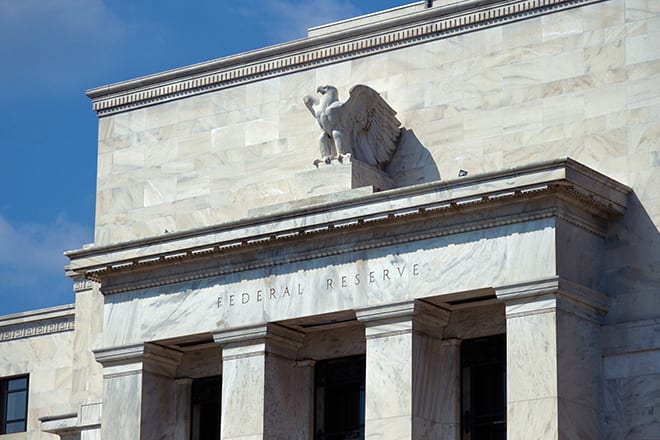Subscribe
Sign up for timely perspectives delivered to your inbox.

Portfolio Managers Jason England and Daniel Siluk believe that, while the Federal Reserve’s (Fed) decision to raise interest rates was both well-telegraphed and justified, the market is likely overestimating the US central bank’s commitment to aggressive tightening.
In a well-telegraphed move, the Federal Reserve (Fed) raised its benchmark overnight policy rate by 25 basis points (bps) on Wednesday to a range of 0.25% to 0.50%. Perhaps more importantly, the US central bank’s own forecast for the future path of rate hikes – as expressed in its “Dots” survey, which records each Fed official’s projection for the federal funds rate – increased to seven hikes for this year and four for 2023. In the December survey, these expectations were for three hikes in each of these years.
While some may interpret this as a continuation in the shift toward a hawkish bias, we are more circumspect. We believe that the seven 25 bps rate increases the futures market is pricing in for this year very much represent an upper limit of potential hikes and that this scenario is unlikely to materialise. Also, the current Dots survey comes with a considerable caveat: There were fewer voting members at this week’s meeting due to the ongoing transition in the Fed’s leadership composition and none of President Biden’s nominees have taken their seat. Importantly, we believe that eventual new members will lean towards the dovish camp, reinforcing our view that the market’s expectations have gotten ahead of reality. It’s worth recalling that throughout Chairman Jerome Powell’s tenure, when given the choice between two paths – and having not been mugged by multi-decade highs in inflation – he’s opted for greater accommodation.
The reality that Chairman Powell has been unable to avoid is that inflation remains on the march. In February, both the headline and core US consumer price indexes reached multi-decade highs – 7.9% and 6.4%, respectively. Market expectations for price increases to drift towards the Fed’s preferred 2.0% long-term range look slim. Inflation is expected to average 3.6% over the next five years based on the US Treasury Inflation-Protected Securities (TIPS) market. For the 10-year horizon, the average is a modestly less ulcer-inducing 2.95%. We interpret these elevated levels as the market’s growing recognition that the Fed will be more tolerant of a pace of inflation seldom seen in the US over the past three decades.
Yet the Fed faces a conundrum. Much of the current upward lurch in prices is due to supply constraints. The global pandemic famously caused supply disruptions in semiconductors and other important industrial inputs. Labour shortages have led to upward pressure on wages, which feed directly into inflation, especially in service-based economies. Unfortunately for the Fed, the blunt instrument of rate hikes tends to be less effective in combatting inflation driven by supply factors than it is in quelling periods of accelerating prices driven by full-throttle demand.
The nature of this bout of inflation, which has been exacerbated by recent geopolitical events, amplifies our concerns about the potential for monetary policy error. Policymakers must perform a perilous balancing act. Should the Fed overtighten, the US economy could slip into recession. If it falls behind the curve and higher inflation expectations become embedded, bond valuations could come under pressure as higher discounts are commanded to compensate for the diminished value of future cash flows.
The expected template of a methodical pace of rate increases in 2022 has been turned upside down. We believe that every Fed meeting has the potential to be “live,” meaning that a rate hike is possible. While it would likely be well-telegraphed per Chairman Powell’s modus operandi, we cannot rule out a 50 bps hike at some point.
The forced shift in the Fed’s stance, however, means that the period of ‘peak policy uncertainty’ has likely been extended. Our view is that the Fed will make every attempt to proceed with caution. Yet, this same caution could lead to even more volatility in longer-dated rates as the risk of higher-than-trend inflation becomes fixed in investors’ minds.
Consequently, we believe investors should treat interest rate exposure – or duration – with caution. Longer-dated bonds, in our view, appear most vulnerable to elevated volatility. And given the relative flatness of the yield curve, the incremental return for holding farther out maturities may not be worth the higher risk. Lastly, the geopolitical uncertainty emanating from events in Ukraine further reinforces our view that now is not the time to take on any undue risk in one’s fixed income allocation.
Basis point (bp) equals 1/100 of a percentage point. 1 bp = 0.01%, 100 bps = 1%.
Duration measures a bond price’s sensitivity to changes in interest rates. The longer a bond’s duration, the higher its sensitivity to changes in interest rates and vice versa.
Inflation: The rate at which the prices of goods and services are rising in an economy.
Volatility: The rate and extent at which security prices move up and down. Large movements indicate high volatility.
Yield curve: A graph that plots the yields of similar quality bonds against their maturities. In a normal/upward sloping yield curve, longer maturity bond yields are higher than short-term bond yields. A yield curve can signal market expectations about a country’s economic direction.